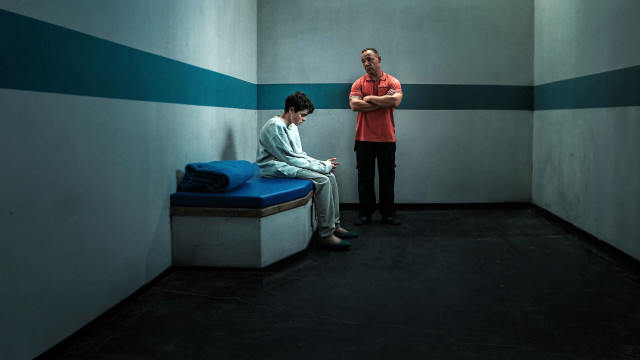




























© Shutterstock
0 / 29 Fotos
© Getty Images
1 / 29 Fotos
Kissing bugs
- It is carried by kissing bugs (scientific name triatomine), which crawl out at night and bite exposed human skin in order to feed on the victim’s blood.
© Getty Images
2 / 29 Fotos
Infection
- The bugs then urinate and/or defecate near the site of the bite, so that when the victim scratches the area, the parasite enters their bloodstream.
© Getty Images
3 / 29 Fotos
Symptoms
- Carriers of this nasty disease can present with a number of symptoms varying in severity. It disproportionately affects poor communities all over the world.
© Getty Images
4 / 29 Fotos
Number crunch
- Recent estimates put the yearly number of Chagas deaths at 10,000, and for years the disease has gone largely under the radar.
© Getty Images
5 / 29 Fotos
The status quo
- In 2022, health workers and researchers from around the world are hoping to raise awareness of Chagas disease, while at the same time reducing its prevalence.
© Getty Images
6 / 29 Fotos
Rising to the challenge
- There are reasons for these proponents of change to feel optimistic, but they are definitely dealing with a difficult beast.
© Getty Images
7 / 29 Fotos
Uphill battle
- Chagas disease is so threatening and destructive because it is extremely difficult to combat in terms of diagnosis, treatment, and aftercare.
© Getty Images
8 / 29 Fotos
The problem with diagnosis
- Firstly, diagnosis is difficult because it requires the patient to undergo several tests in a lab staffed with knowledgeable health workers.
© Getty Images
9 / 29 Fotos
The problem with diagnosis
- This is simply not possible in many areas where Chagas is rife, and it is estimated that only one in 10 people infected by the parasite is actually diagnosed.
© Getty Images
10 / 29 Fotos
Silent illness
- This scenario is complicated by the fact that a person can actually carry the infection for up to 30 years, if it does not prove fatal first.
© Getty Images
11 / 29 Fotos
Silent illness
- The disease is a slow burner and can even lead to heart failure years after the initial infection. It is for this reason that people sometimes refer to it as the ‘silent illness.’
© Getty Images
12 / 29 Fotos
The problem with treatment - For those patients who are accurately diagnosed with Chagas disease, treatment options are few and those that do exist are unappealing, to say the least.
© Getty Images
13 / 29 Fotos
The problem with treatment
- To be treated with benznidazole, for example, the patient must take the drug for 60 days, and it comes with some pretty terrible side effects.
© Shutterstock
14 / 29 Fotos
Straight from the horse's mouth
- According to Oscar Ledesma Patiño, a pediatric specialist who has been working on Chagas since the 1970s, the right drug simply “doesn’t exist.”
© Getty Images
15 / 29 Fotos
Adding insult to injury
- And to make matters even worse, once a patient has gone through the ordeal of treatment, doctors can’t even tell them whether they have been cured.
© Getty Images
16 / 29 Fotos
Adding insult to injury - This is because the immune system forgets the parasite; it can take up to 10 years for tests to confirm that it is really gone from the body for good.
© Getty Images
17 / 29 Fotos
Making progress
- As mentioned earlier, those battling to raise awareness of and eliminate Chagas are gaining impressive ground, especially considering the level of resistance they face.
© Getty Images
18 / 29 Fotos
The challenge
- In Argentina, for example, the use of resources to fight Chagas is uneven. In certain provinces, the funds allocated to combat the disease aren’t even spent.
© Shutterstock
19 / 29 Fotos
The impact of COVID-19
- This problem was exacerbated by the COVID-19 pandemic which put a stop to house-to-house bug spraying in some areas.
© Getty Images
20 / 29 Fotos
Local resistance
- Even in areas that are well-resourced, the fight to eradicate Chagas is sometimes met with local resistance.
© Getty Images
21 / 29 Fotos
Local resistance
- According to one BBC article, a social worker in Santiago del Estero had to visit an at-risk woman for two months before she’d let her fumigate her home.
© Getty Images
22 / 29 Fotos
Rapid testing
- There is reason to have hope, however. There is already technology out there that can be used for rapid tests that would transform the diagnostic process.
© Getty Images
23 / 29 Fotos
The DNDi - The Drugs for Neglected Diseases Initiative (DNDi) is also trialing a shorter benznidazole treatment, one that lasts two weeks rather than two months.
© Getty Images
24 / 29 Fotos
Benznidazole - Benznidazole may be an imperfect treatment for Chagas, but shortening the course would make the side effects more manageable and hopefully increase uptake.
© Getty Images
25 / 29 Fotos
Other drugs
- New drugs are also in the pipeline, although it may well be years before these are available for use.
© Shutterstock
26 / 29 Fotos
Researching the kissing bug
- At the same time, researchers are looking into the kissing bug’s microbiome in order to better understand the bacterial environment required for the transmission of the infection.
© Getty Images
27 / 29 Fotos
Researching the kissing bug
- This, in turn, may enable scientists to genetically manipulate the kissing bug and therefore block the development of the parasite. Sources: (BBC)
© Getty Images
28 / 29 Fotos
© Shutterstock
0 / 29 Fotos
© Getty Images
1 / 29 Fotos
Kissing bugs
- It is carried by kissing bugs (scientific name triatomine), which crawl out at night and bite exposed human skin in order to feed on the victim’s blood.
© Getty Images
2 / 29 Fotos
Infection
- The bugs then urinate and/or defecate near the site of the bite, so that when the victim scratches the area, the parasite enters their bloodstream.
© Getty Images
3 / 29 Fotos
Symptoms
- Carriers of this nasty disease can present with a number of symptoms varying in severity. It disproportionately affects poor communities all over the world.
© Getty Images
4 / 29 Fotos
Number crunch
- Recent estimates put the yearly number of Chagas deaths at 10,000, and for years the disease has gone largely under the radar.
© Getty Images
5 / 29 Fotos
The status quo
- In 2022, health workers and researchers from around the world are hoping to raise awareness of Chagas disease, while at the same time reducing its prevalence.
© Getty Images
6 / 29 Fotos
Rising to the challenge
- There are reasons for these proponents of change to feel optimistic, but they are definitely dealing with a difficult beast.
© Getty Images
7 / 29 Fotos
Uphill battle
- Chagas disease is so threatening and destructive because it is extremely difficult to combat in terms of diagnosis, treatment, and aftercare.
© Getty Images
8 / 29 Fotos
The problem with diagnosis
- Firstly, diagnosis is difficult because it requires the patient to undergo several tests in a lab staffed with knowledgeable health workers.
© Getty Images
9 / 29 Fotos
The problem with diagnosis
- This is simply not possible in many areas where Chagas is rife, and it is estimated that only one in 10 people infected by the parasite is actually diagnosed.
© Getty Images
10 / 29 Fotos
Silent illness
- This scenario is complicated by the fact that a person can actually carry the infection for up to 30 years, if it does not prove fatal first.
© Getty Images
11 / 29 Fotos
Silent illness
- The disease is a slow burner and can even lead to heart failure years after the initial infection. It is for this reason that people sometimes refer to it as the ‘silent illness.’
© Getty Images
12 / 29 Fotos
The problem with treatment - For those patients who are accurately diagnosed with Chagas disease, treatment options are few and those that do exist are unappealing, to say the least.
© Getty Images
13 / 29 Fotos
The problem with treatment
- To be treated with benznidazole, for example, the patient must take the drug for 60 days, and it comes with some pretty terrible side effects.
© Shutterstock
14 / 29 Fotos
Straight from the horse's mouth
- According to Oscar Ledesma Patiño, a pediatric specialist who has been working on Chagas since the 1970s, the right drug simply “doesn’t exist.”
© Getty Images
15 / 29 Fotos
Adding insult to injury
- And to make matters even worse, once a patient has gone through the ordeal of treatment, doctors can’t even tell them whether they have been cured.
© Getty Images
16 / 29 Fotos
Adding insult to injury - This is because the immune system forgets the parasite; it can take up to 10 years for tests to confirm that it is really gone from the body for good.
© Getty Images
17 / 29 Fotos
Making progress
- As mentioned earlier, those battling to raise awareness of and eliminate Chagas are gaining impressive ground, especially considering the level of resistance they face.
© Getty Images
18 / 29 Fotos
The challenge
- In Argentina, for example, the use of resources to fight Chagas is uneven. In certain provinces, the funds allocated to combat the disease aren’t even spent.
© Shutterstock
19 / 29 Fotos
The impact of COVID-19
- This problem was exacerbated by the COVID-19 pandemic which put a stop to house-to-house bug spraying in some areas.
© Getty Images
20 / 29 Fotos
Local resistance
- Even in areas that are well-resourced, the fight to eradicate Chagas is sometimes met with local resistance.
© Getty Images
21 / 29 Fotos
Local resistance
- According to one BBC article, a social worker in Santiago del Estero had to visit an at-risk woman for two months before she’d let her fumigate her home.
© Getty Images
22 / 29 Fotos
Rapid testing
- There is reason to have hope, however. There is already technology out there that can be used for rapid tests that would transform the diagnostic process.
© Getty Images
23 / 29 Fotos
The DNDi - The Drugs for Neglected Diseases Initiative (DNDi) is also trialing a shorter benznidazole treatment, one that lasts two weeks rather than two months.
© Getty Images
24 / 29 Fotos
Benznidazole - Benznidazole may be an imperfect treatment for Chagas, but shortening the course would make the side effects more manageable and hopefully increase uptake.
© Getty Images
25 / 29 Fotos
Other drugs
- New drugs are also in the pipeline, although it may well be years before these are available for use.
© Shutterstock
26 / 29 Fotos
Researching the kissing bug
- At the same time, researchers are looking into the kissing bug’s microbiome in order to better understand the bacterial environment required for the transmission of the infection.
© Getty Images
27 / 29 Fotos
Researching the kissing bug
- This, in turn, may enable scientists to genetically manipulate the kissing bug and therefore block the development of the parasite. Sources: (BBC)
© Getty Images
28 / 29 Fotos
Chagas disease: the parasite that lurks for decades
Learn all about the "sleeping sickness"
© Shutterstock
Chagas disease, which is otherwise known as American trypanosomiasis, is a tropical parasitic disease caused by the Trypanosoma cruzi parasite.
It is commonly referred to as the "silent illness" or the "sleeping sickness," because once infected a person can carry the parasite for decades before serious symptoms develop.
For years, many communities have been plagued by Chagas disease because not enough has been done to develop proper diagnostic tactics or treatments.
Check out this gallery to learn all about Chagas disease.
RECOMMENDED FOR YOU




































MOST READ
- Last Hour
- Last Day
- Last Week








